The Army That Fought Back
“...those folks arriving in our county instinctively knew they should go to The Salvation Army.”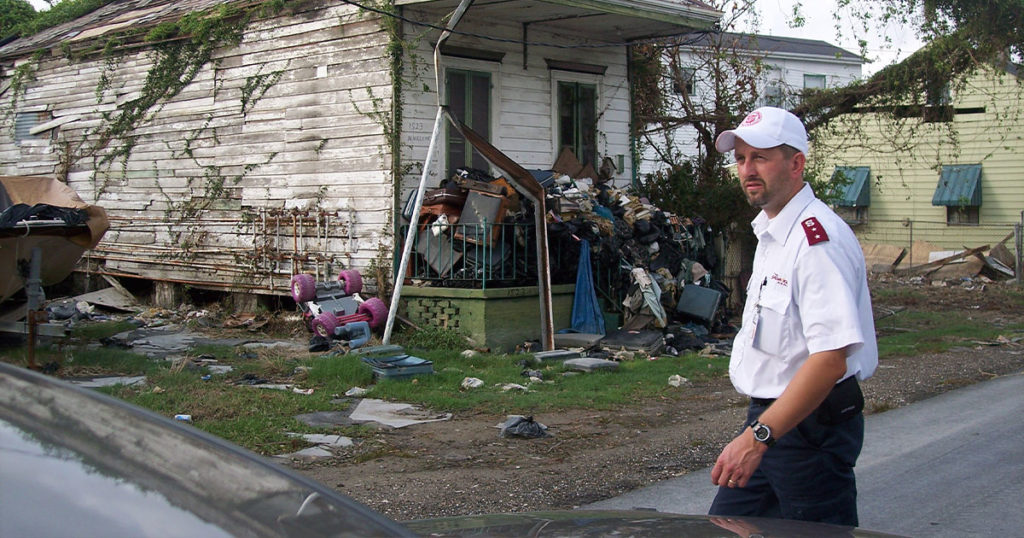
On August 29, 2005, Hurricane Katrina devastated the Gulf Coast, exacting upon the region destruction one might imagine in total war. The disaster claimed over 1,800 lives, destroyed over 800,000 homes and displaced over a million people. Like an invading army toppling a fortified city, Katrina broke through New Orleans’ many levees, flooding 80% of the city. The damages caused by Hurricane Katrina remain the costliest in American history. Nevertheless, even as it ruthlessly battered the region, an opposing army had already begun its counteroffensive, meeting the needs of survivors in Jesus’ name.
Twenty years later, The Salvation Army continues the fight to reclaim and rebuild in the wake of disasters both natural and manmade. The heroism shown by the officers, soldiers, employees and volunteers of The Salvation Army in those early days after Hurricane Katrina informs and inspires that present engagement. These are their stories.
On Sunday, August 28, 2005, Majors Richard and Faye Brittle, area commanders of New Orleans, discovered several dozen men, women and children wanting to shelter at The Center of Hope because they couldn’t evacuate. The Brittles welcomed them in. Between the new additions and the shelter clients there already, 239 individuals had elected to stay there in preparation for the fearsome hours to follow.
The storm came that night, and in the early morning, Majors Brittle assumed the building and its occupants had survived it unscathed. Then the levees broke. The power went out. Water began pouring into the city. They spent the rest of Monday and Tuesday gathering supplies as the water continued to rise across the city. By Wednesday afternoon, many more people came to them looking for a dry place to stay. Despite their lack of supplies, the Brittles took in everyone that arrived there. The number of occupants soon tallied over 300 — the youngest was a six-week-old infant, and the oldest was an 88-year-old woman carried there by her son.
By Wednesday night, water was seeping into the first floor and the elevator shaft. Already, everyone had relocated to the second, third and fourth floors. Thursday morning, The Center of Hope residents woke up to 18 inches of water on the first floor, supplies dwindling, and a kitchen that could not be used. While the water at the center never rose above 18 inches, the area command and corps buildings were inundated with six feet of water. Just outside The Center of Hope, at the lowest point in the area, the water plummeted to approximately 14 feet deep. Leaving to resupply was simply not an option.
“For meals during the week, we had canned food items. For breakfast one morning, the kids had peaches in a cup and the men got a breakfast bar. Juice was very limited because we didn’t have a lot of water,” said Major Richard. “My wife had boiled water on the stove in big pots. We took those upstairs and for some of the meals, they only got a half a cup a juice. For one meal they got a slice of bread with a little tuna on it and some cuts of cantaloupe. The kids got peanut butter and crackers, and we just weathered it out.”
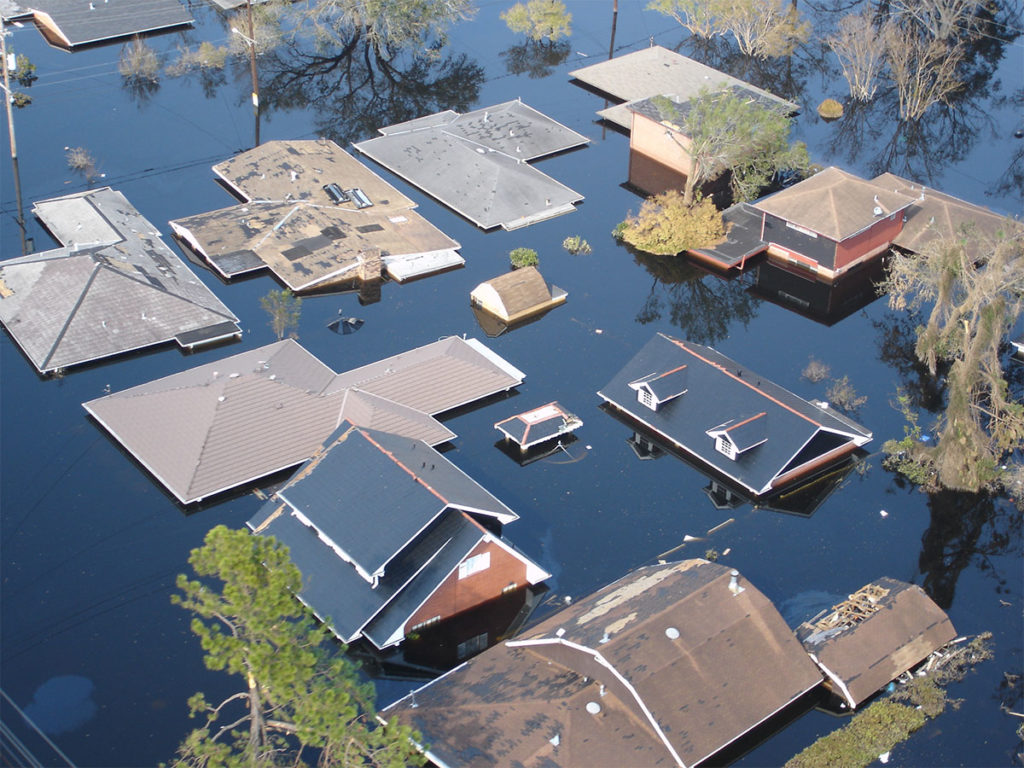
Finally, on Friday, September 2, 2005, help arrived when a military helicopter began to rescue them from the rooftop. For five days, they had managed without outside assistance, contending with little food, widespread dehydration, and extreme heat with temperatures reaching 95 degrees outside and 120 inside.
“We prayed a lot. Day and night, I made rounds throughout the building to make sure that everybody was secure and safe because of what we were hearing was happening at the Superdome … The men would gather and have a prayer meeting, and the women even set up a little church in one of the empty apartments that was unusable for shelter as such. They had a little church time in there.”
At Bible Conference in Lake Junaluska, NC, Major Danny Delaney, administrator for the New Orleans Adult Rehabilitation Center (ARC), saw on TV that Katrina was heading to New Orleans as a category 5 hurricane. He called his wife, Major Linda Delaney, who was in New Orleans, and she began to evacuate the 130 men at the center, 54 employees and her family to the Houston ARC. “At the last minute, we said that we’d better get everybody out of there. She went home in the middle of the night and got our family out too,” Delaney said. “She’d already sent the men out to Houston. She’d borrowed vehicles from everywhere, and we had vehicles that were given to us to get the men out.”
Major Danny and the 11 ARC residents with him made the arduous journey from the Blue Ridge Mountains to Houston, taking a circuitous route given the road closures and traffic. “All the way there, there were people all over the highway. Everywhere we stopped there were people. Being with The Salvation Army we had the shield all over the vehicles and people wanted help, money, counseling and prayers. We prayed with hundreds of people.”
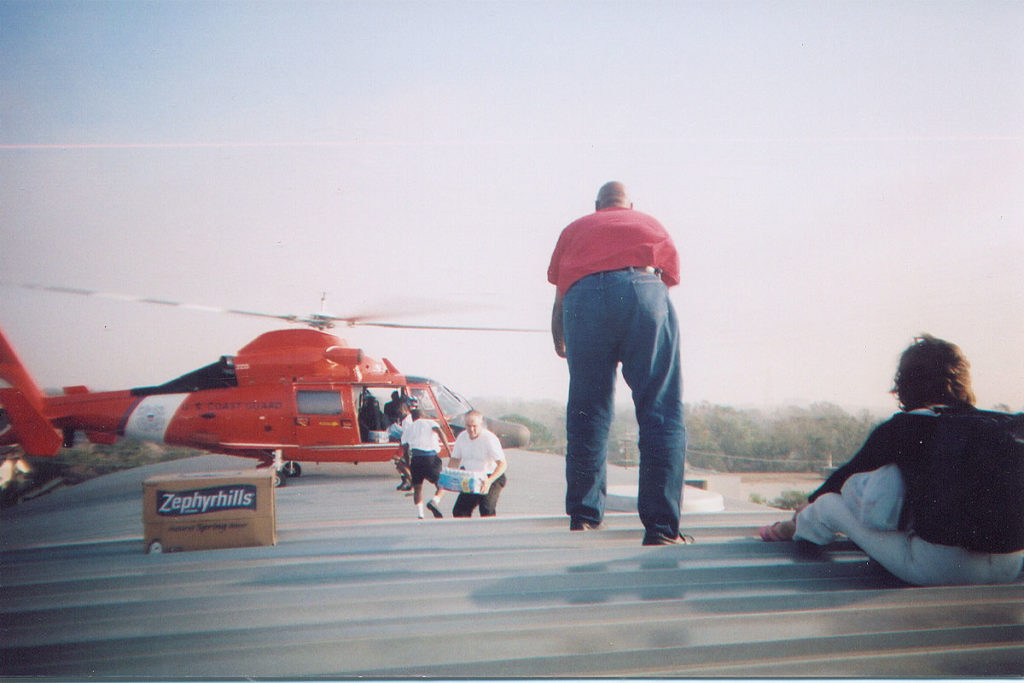
Majors Delaney, their family, and a few of the men returned to New Orleans several days later to assess the damage to the center and retrieve items left there. Delaney recalls, “When we got close to the center, it was all flooded … we wondered how we would get to the center with the flood. There were two boats there. God must have put them there! We all got into one flat-bottom boat … We rode into the center and when we got closer, we got out and waded in. The water was up to our chest.” In the remainder of their time in Houston, they made the trip to the New Orleans ARC several times, retrieving documents, mementos and other items for the men. Major Linda, determined to find a place for every resident to go, found placements for all the men at centers around the South.
The Bureau of Labor Statistics estimates that Katrina forced over 1.5 million Americans to evacuate the Gulf Coast of Alabama, Mississippi and Louisiana. Many of those evacuees had no place to go, relying on relief organizations like The Salvation Army for assistance. At the Army’s administrative office in Baton Rouge, LA, some 40 Salvation Army canteens served hot meals and supplies to thousands of evacuees for months.
In Gwinnett County, GA, then Captains Bobby and Anne Westmoreland thought they could be deployed to assist with the relief effort along the Gulf Coast. Little did they know that the relief effort would come to them as Katrina was battering New Orleans.
“It was Monday afternoon when person after person began to show up at The Salvation Army. We had not issued any information. It was almost as if those folks arriving in our county instinctively knew that they should go to The Salvation Army,” Westmoreland recalls, describing how the corps quickly organized into a hurricane assistance center.
The Westmorelands began working with counselors to provide emotional support, and they secured necessities like clothing, shelter and food. “We needed to find them a place to stay. We needed to get them clothing if they needed clothing. We needed to get them food if they needed food. We had to get them personal hygiene things. We needed to give them comfort … Those first days of realizing what was happening would eventually mean that over 20,000 people showed up on our doorstep here in Lawrenceville, Georgia.”
Over 5,000 volunteers assisted The Salvation Army Lawrenceville Corps with its efforts. They assisted with feeding programs, provided vouchers for Walmart and distributed supply boxes. A variety of supplies entered each box from canned goods to Christian literature, including a copy of The War Cry. Trained ministers attended to praying with survivors, and other volunteers cared for children as parents received their boxes. On Sundays, evacuees entered the corps for worship and healing. On one Sunday, three families came forward to the front of the chapel, and the whole congregation gathered around them and prayed for their needs.
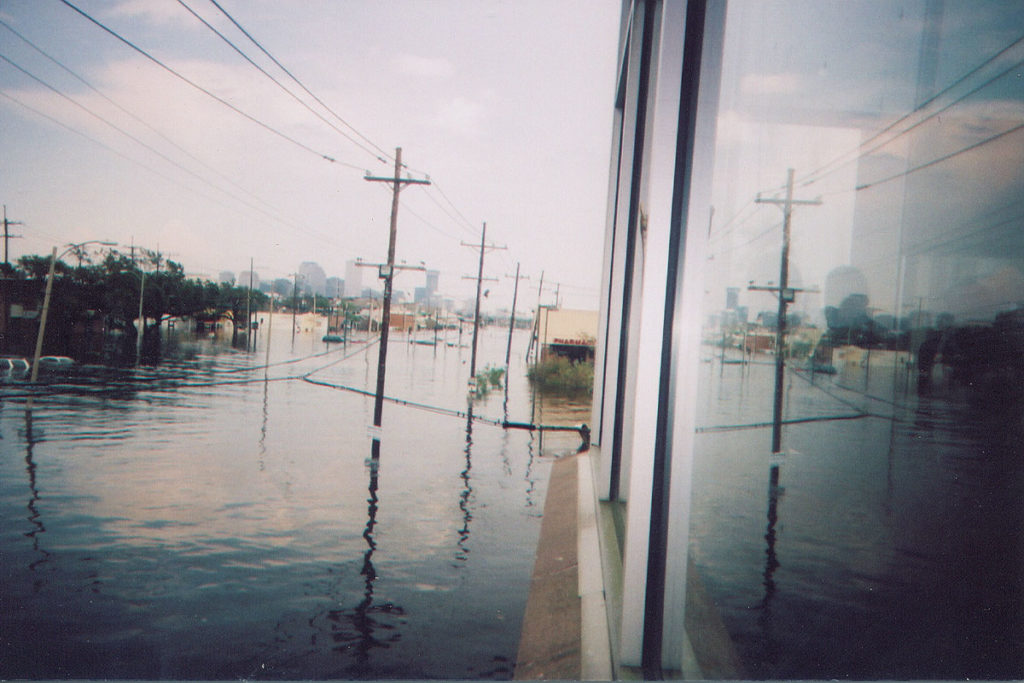
As evacuees caravaned into other regions of the country, Sally Lohrbach, office manager at The Salvation Army Gulfport, MS Corps, and her husband Loren stayed in their home, ready to report to work once the storm surge receded. “I work for The Salvation Army; we love the Lord and we live our lives to serve Him. When the evacuation recommendation came we spent a lot of time in prayer knowing that both of our jobs were in the disaster recovery business. We believe that we’re called to our jobs and place in life by the Lord,” Lohrbach said.
Katrina’s rain beat against their roof and water leaked through their roof. The Lohrbachs grabbed whatever they could to catch water as new leaks formed, trying to save their carpet from the dripping. Yet, the Lohrbachs didn’t anticipate how inundated with water their house would soon become, and before long, water would flood into their home, eventually becoming waist deep. They weathered the rest of the storm from the attic, and once Katrina had passed, they exited the house to find a pine tree fallen on one part of the roof and a hole in another.
Despite the damage to their home, the Lohrbachs went to The Salvation Army and, as planned, got to work. They distributed water and other supplies. After volunteers cleared the roads of felled trees to allow emergency canteens to arrive, they served meals to hundreds of people. Sally even assisted the divisional commander, Major Dalton Cunningham, with initially assessing the damage to The Salvation Army’s other facilities.
“Our real home is in the Lord, and that’s the thing that sustained us from the stress of the hurricane … you have this commitment that you’ve made that you have to honor. How are you going to handle that? It’s the Lord who sustained us through that decision-making process. He sustained us through every little decision that we had to make about how to find a new normal in life; how to do what is important about the things that we used to do; which of those things should we continue to carry on, in spite of the changes in our circumstances …” said Sally.
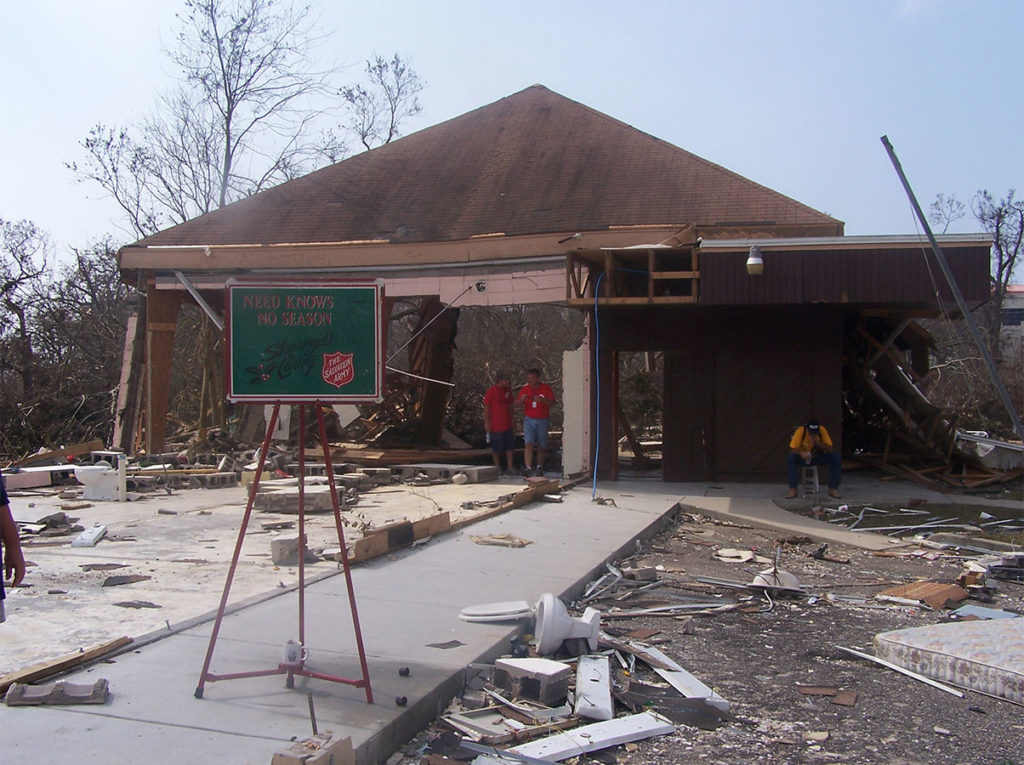
“It’s amazing to me that when people see the shield of The Salvation Army, that no matter what their need is, they feel comfortable with stopping and asking you if you can help or if you can’t, do you know who can? They just feel so comfortable with that shield; sometimes they don’t even know that it’s a church; they don’t even know that it’s the love of Jesus that’s on the inside. That shield has such a recognized place in the community that when they’re in trouble, they will stop and knock on the door because they know they’re going to get some kind of help if they can get somebody’s attention where that shield is shown.”
Each of the above vignettes represents thousands of Salvation Army officers, employees and volunteers who served suffering humanity in the storm-affected areas and beyond. Some ministered to survivors as wind and rain raged. Some welcomed evacuees with food, shelter and prayers. Others joined the fight as the waters receded, attending to the needs of other survivors before their own. In the end, their service produced astonishing results and rescued countless men, women and children from Katrina’s brutal effects. Salvation Army personnel served one million hot meals to more than 30,000 survivors and emergency responders in the immediate aftermath of Katrina. In the months following, the Army in New Orleans processed 600 clients a day for social service assistance. The Army assisted thousands with long-term recovery and rebuilt thousands of homes.
Hurricane Katrina invaded the Gulf Coast, afflicting its residents with destruction and death. In the face of profound challenges and deep sorrows, The Salvation Army countered Katrina’s devastation with the love of God and in the hope that comes from fighting darkness with the light of Christ. The men and women who answered God’s call to service in those days showed that, though waters roar and the earth give way into the heart of the sea, we have no need to fear. “The Lord Almighty is with us” (Psalm 46:7 NIV).
Editor’s Note: This article was written from previously unpublished interviews conducted by Major James R. Worthy in the months following Hurricane Katrina. Major Worthy was promoted to Glory on November 28, 2009.







